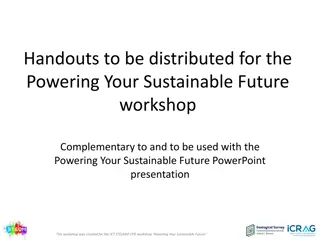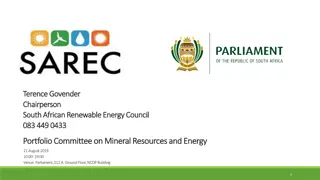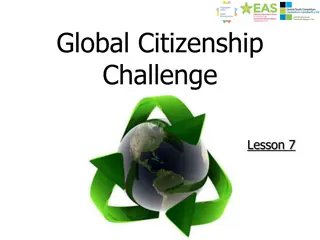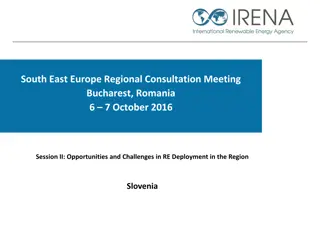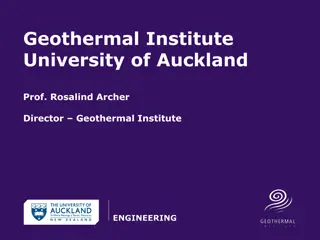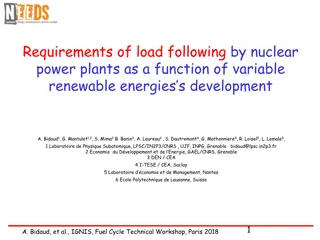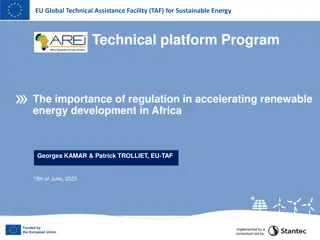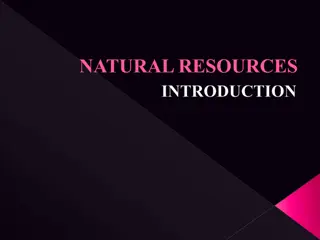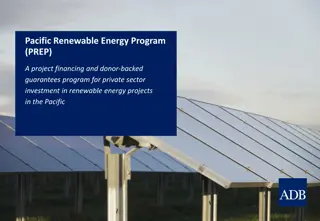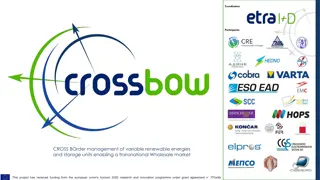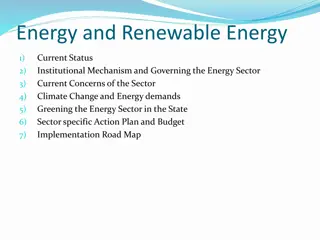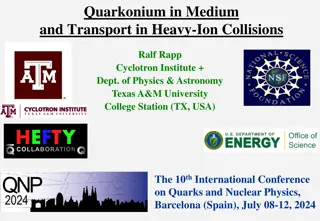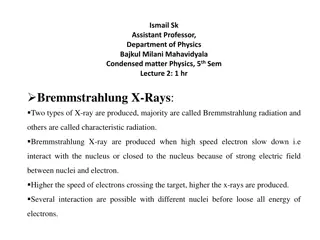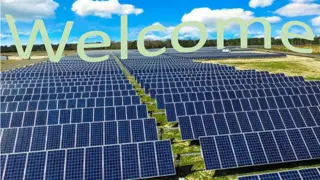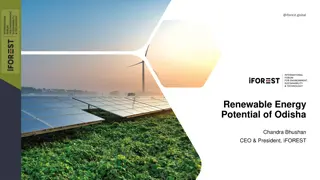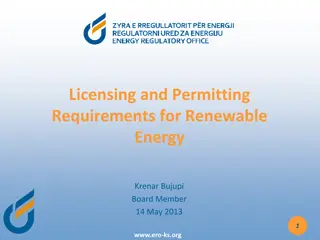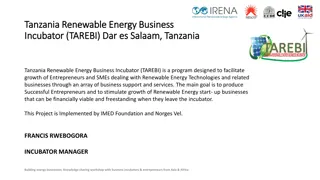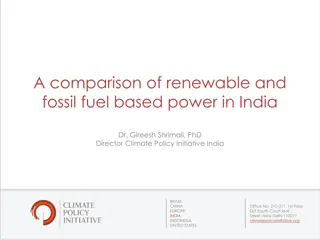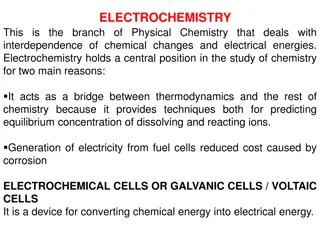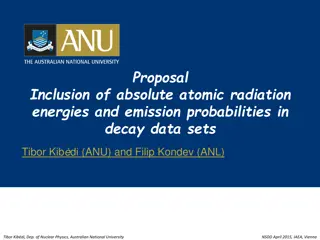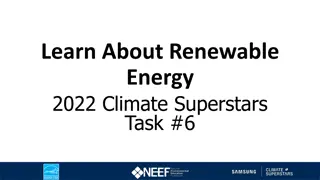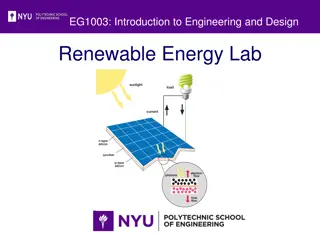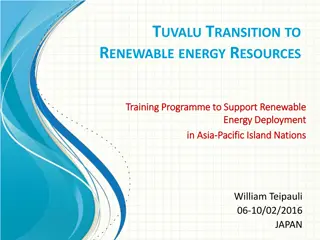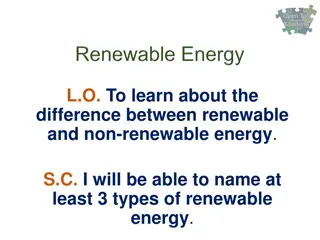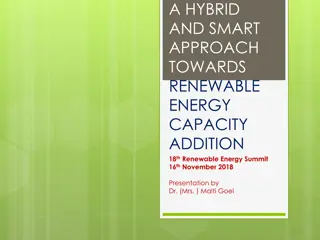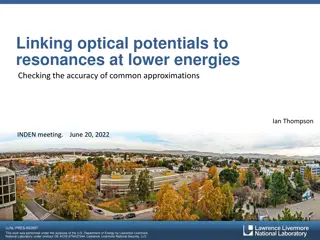Renewable Energy Market
The global renewable energy market was valued at $881.7billion in 2020, and is projected to reach $1,977.6 billion by 2030, growing at a CAGR of 8.4% from 2021 to 2030. Renewable energy, even referred as clean energy, is usually derived from natural sources that are constantly replenished.
1 views • 6 slides
Swellendam Municipality's Renewable Energy Initiatives and Strategic Vision
Swellendam Municipality, located in the Overberg district of South Africa, is strategically positioned to drive renewable energy initiatives for economic stability and growth. With a focus on green economy development, the municipality aims to reduce dependence on ESKOM, support local investment, an
1 views • 33 slides
Renewable Energy
These resources support practitioners in delivering renewable energy concepts for engineering and manufacturing qualifications at levels 2 and 3. Topics covered include sources of renewable energy, advantages and disadvantages, planning for renewable energy, delivery suggestions, energy calculations
5 views • 19 slides
Exploring Renewable Energy Sources in Portlaoise Workshop Overview
This workshop, designed for the JCT STE(A)M CPD workshop "Powering Your Sustainable Future," delves into renewable energy sources - wind, solar, and geothermal energies - in the Portlaoise area. Participants will analyze the social, economic, and environmental aspects of each energy source based on
0 views • 6 slides
Overview of Energy Resources: Renewable and Non-Renewable
Energy resources are classified into renewable and non-renewable types, with a mix of both used worldwide. Non-renewable resources dominate global energy consumption, with fossil fuels like oil, natural gas, coal, and nuclear energy being major sources. While non-renewable sources still dominate, ef
1 views • 20 slides
Exploring Renewable Energy Options on Moja Island
Explore the initiative on Moja Island to identify suitable renewable energy options for its communities, aiming to bridge the energy gap and improve lives. Join the task of suggesting renewable energy solutions for the four main communities on the island, guided by the belief that sustainable energy
0 views • 10 slides
Advancing Renewable Energy in South Africa: SAREC Presentation Highlights
SAREC, the South African Renewable Energy Council, plays a vital role in promoting the renewable energy sector in South Africa. Their objectives include supporting a just energy transition, engaging with government, promoting excellence in renewable energy, and collaborating with various organizatio
4 views • 20 slides
Understanding Renewable Energy for a Sustainable Future
This lesson focuses on the importance of renewable energy in meeting future energy needs sustainably. Students discuss and differentiate between renewable and non-renewable energy sources, analyze energy generation in Wales, and make decisions on investing in renewable energy options. They also eval
0 views • 6 slides
Insights into Parton Branching Equation at LHC Energies
Multiplicity distributions play a crucial role in understanding the cascade of quarks and gluons at the LHC energies, revealing underlying correlations in particle production. Popular models like Monte Carlo and statistical models are used to describe the charged particle multiplicity distributions.
1 views • 17 slides
Renewable Energy Deployment in Slovenia: Achieving Targets and Overcoming Challenges
The content provides insights into Slovenia's progress in renewable energy deployment, focusing on achieving targets and combating challenges. It covers topics such as renewable energy targets, sectoral goals, RES utilization, and the role of various renewable sources in the country. Statistical dat
0 views • 19 slides
Renewable Energy Committee Progress Report June 2014
The Renewable Energy Committee Progress Report for June 2014 highlights the importance of renewable energy in the current economic and environmental landscape. It discusses trends, objectives, activities, and areas of focus related to renewable energy. The report underscores the global shift towards
1 views • 11 slides
Renewable Energy and Energy Efficiency in West Africa: Current Status and Future Prospects
The content discusses the vision, challenges, potentials, constraints, and establishment of the Economic Community for West African States (ECOWAS) Centre for Renewable Energy and Energy Efficiency (ECREEE) in West Africa. It highlights the region's significant renewable energy potentials, the barri
0 views • 10 slides
Understanding Electronic Excitation in Semiconductor Nanoparticles from a Real-Space Quasiparticle Perspective
This research delves into the electronic excitation in semiconductor nanoparticles, focusing on real-space quasiparticle perspectives. It explores treating electron correlation using explicit operators, leading to faster algorithms while calculating optical gap and exciton binding energies. Various
0 views • 45 slides
Key Fusion Reactions in Nuclear Astrophysics
Fusion reactions play a crucial role in nuclear astrophysics, with key reactions involving light elements such as Li, Be, B, and stable carbon isotopes. Understanding fusion of light heavy nuclei at extreme energies is essential for predicting stellar evolution. The S-factor provides a convenient re
0 views • 31 slides
Geothermal Institute at University of Auckland - Advancing Renewable Energy Solutions
The Geothermal Institute at University of Auckland, led by Prof. Rosalind Archer, specializes in geoscience, reservoir engineering, and renewable energy technologies. Their research projects range from fundamental geoscience to societal implications in energy markets. The institute offers educationa
0 views • 13 slides
Load Following by Nuclear Power Plants in Relation to Variable Renewable Energies' Development
The study explores the requirements of load following by nuclear power plants in the context of variable renewable energies' growth. It discusses the impact of renewable energy development on nuclear economic models and the need for dispatchable capacities. Benchmarks are set to test robustness of d
0 views • 11 slides
Importance of Regulation in Accelerating Renewable Energy Development in Africa
The presentation discusses the significance of regulation in driving the development of renewable energy in Africa. It emphasizes key legal and regulatory requirements such as tariff principles, unbundling, incentives for renewable energy, competition, and transparent procedures. The need for sector
0 views • 22 slides
Understanding Natural Resources: Types and Conservation
Natural resources play a crucial role in sustaining life on Earth, encompassing elements like water, air, soil, minerals, and more. These resources can be classified into renewable and non-renewable categories, with the former being replenishable through natural cycles and the latter being finite an
0 views • 24 slides
Pacific Renewable Energy Program (PREP) Overview and Financing Details
The Pacific Renewable Energy Program (PREP) offers project financing and donor-backed guarantees to facilitate private sector investment in renewable energy projects in the Pacific region. By addressing short and long-term liquidity risks, PREP aims to attract investors to develop solar and wind pro
0 views • 4 slides
Analysis of Renewable Energy Policies in the Liberalised EU Energy Market
This study examines the global competitiveness of the energy forum in a liberalised EU energy market, focusing on renewable electricity in EU member states. It delves into the energy balance, political context regarding European climate targets, industry involvement, and the financial context of ren
0 views • 16 slides
Cross-Border Management of Variable Renewable Energies and Storage Units
This EU-funded project, CROSSBOW, addresses industrial challenges and standards needs for managing variable renewable energies and storage units. It focuses on system integration with smart transmission grids and storage technologies to increase renewables' share. The project tackles four major inno
0 views • 11 slides
Renewable Energy Status and Trends in Tamil Nadu: Challenges and Opportunities
Renewable energy accounts for a significant portion of Tamil Nadu's electricity grid capacity, with a focus on wind energy. Despite this, the actual energy generated from renewable sources remains low. The state faces challenges such as high electricity consumption, sector-wise variations, and trans
0 views • 18 slides
Quarkonium in Medium and Transport in Heavy-Ion Collisions
Discussing the properties and behavior of quarkonium in medium and its transport in heavy-ion collisions. Topics include heavy-quark potential, confinement, quarkonia at finite temperature, quarkonium transport, and quarkonia in heavy-ion collisions. Insightful details about in-medium potential and
0 views • 30 slides
Understanding Bremmstrahlung and Characteristic X-Rays in Condensed Matter Physics
In condensed matter physics, Bremmstrahlung X-rays and characteristic X-rays are produced through different interactions of high-speed electrons with nuclei in target atoms. Bremmstrahlung radiation is generated when electrons slow down near the nucleus, while characteristic radiation is produced wh
0 views • 5 slides
Understanding Atomic Orbitals: Counting, Subshells, Energies, and Electrons
Learn about the basics of atomic orbitals, including the counting of orbitals in shells and subshells, the distribution of electrons in different energy levels, and the symmetrical nature of orbital labeling. Dive into the rules governing electron placement based on quantum mechanics and explore the
0 views • 6 slides
Exploring Renewable and Non-Renewable Energy Sources for Sustainable Living
Discover the diverse world of renewable and non-renewable energy sources with a focus on renewable energy for a sustainable future. Learn about geothermal power, solar power, wind power, tidal power, biomass power, and the advantages and disadvantages of non-renewable energy resources. Engage in dis
0 views • 16 slides
Renewable Energy Potential Assessment in Odisha by iFOREST
Odisha holds significant renewable energy potential, with assessed capacities in solar, biomass, and wind energy. The Odisha Renewable Energy Policy aims to decarbonize the energy sector by leveraging state renewable energy potential, leading to a reduction in CO2 emissions, job creation, and minima
0 views • 4 slides
Renewable Energy Licensing and Permitting Requirements Overview
Discover the institutional responsibilities and targets for renewable energy in a regulatory framework. Learn about feed-in tariffs, authorization procedures, and targets set for various renewable energy sources like hydro, wind, photovoltaic, and biomass. Explore the methodology and processes invol
0 views • 11 slides
Tanzania Renewable Energy Business Incubator Overview
Tanzania Renewable Energy Business Incubator (TAREBI) in Dar es Salaam aims to support entrepreneurs and SMEs in renewable energy technologies. The program provides business support, coaching, networking, and investment support to foster successful, financially viable renewable energy startups. IMED
0 views • 4 slides
RIN Pricing, Market Dynamics, and Policy Issues in Renewable Fuel Sector
The article discusses the Renewable Fuel Standard (RFS), Renewable Identification Numbers (RINs), RIN pricing fundamentals, pass-through effects, and policy implications in the renewable fuel market. It delves into legislative context, fuel categories, biofuels expansion, and a dynamic model of the
0 views • 37 slides
Comparative Analysis of Renewable vs. Fossil Fuel Power in India
The comparison between renewable and fossil fuel-based power in India reveals that the renewable energy sector has historically shown lower risk and higher returns than the fossil fuel sector. Investors perceive renewable energy investments to be less risky, with solar being seen as less risky than
0 views • 23 slides
Understanding Electrochemistry: The Interplay of Chemical Changes and Electrical Energies
Electrochemistry, a branch of Physical Chemistry, explores the relationship between chemical reactions and electrical energies. It serves as a vital link between thermodynamics and other areas of chemistry, offering insights into equilibrium concentrations and facilitating the generation of electric
0 views • 24 slides
Integration of Atomic Radiation Energies and Emission Probabilities in Decay Data Sets
Proposal by Tibor Kibdi and Filip Kondev to include absolute atomic radiation energies and emission probabilities in decay data sets. They emphasize the need for energy and intensity data to be computer-readable and use standard notation. The inclusion of atomic relaxation data into ENSDF is discuss
0 views • 7 slides
Understanding Renewable Energy and its Benefits in 2022
Renewable energy sources like wind, waves, tides, sunlight, geothermal heat, and biomass play a crucial role in combating climate change by reducing greenhouse gas emissions. This task educates about the differences between renewable and non-renewable energy sources, the benefits of renewables, and
0 views • 10 slides
Analysis of Vermont's Renewable Energy Standard and REC System
This document presents an overview of Vermont's Renewable Energy Standard (RES) and Renewable Energy Credits (RECs) system. It covers the establishment of the RES, specific requirements, eligibility criteria for RECs, and the different tiers of the RES. Key topics include the projection of impacts,
0 views • 23 slides
Renewable Energy Lab: Exploring Solar, Wind, and Hydrogen Technologies
Explore the capabilities of solar panels, wind turbines, hydrogen fuel cells, and capacitors in this Renewable Energy Lab. Learn about the harnessed clean energy sources, including solar panels converting sunlight to electricity and wind turbine technology utilizing wind pressure. Design a renewable
0 views • 18 slides
Tuvalu Renewable Energy Transition Programme
Tuvalu is transitioning to renewable energy sources to support sustainable energy deployment in the Asia-Pacific region. With a focus on solar PV, wind, biodiesel, and energy efficiency, the government aims to achieve 100% renewable energy generation by 2020. The implementation strategy includes a m
1 views • 14 slides
Exploring Renewable and Non-Renewable Energy Sources
Understanding the difference between renewable and non-renewable energy sources such as fossil fuels and renewable sources like biomass, hydro-electric, solar, wave, and wind energy. Learn how electricity is generated, the impact on the environment, and the benefits of using renewable energy. Discov
0 views • 15 slides
Innovations in Renewable Energy: A Smart Approach for Sustainable Future
Explore cutting-edge technologies like Floating Renewable Energy Platforms, Hybrid Energy Systems, Metal Air Batteries, and more, presented at the 18th Renewable Energy Summit. Learn about global renewable energy trends, India's capacity addition, and the potential for renewable power growth by 2030
0 views • 16 slides
Exploring Optical Potentials and Resonances at Lower Energies
Investigating the accuracy of common approximations in linking optical potentials to resonances at lower energies. The study focuses on neutron reactions with 14N as a test case, transitioning from R-matrix theory to Hauser-Feshbach models and evaluating known levels and level densities. Key topics
0 views • 22 slides



